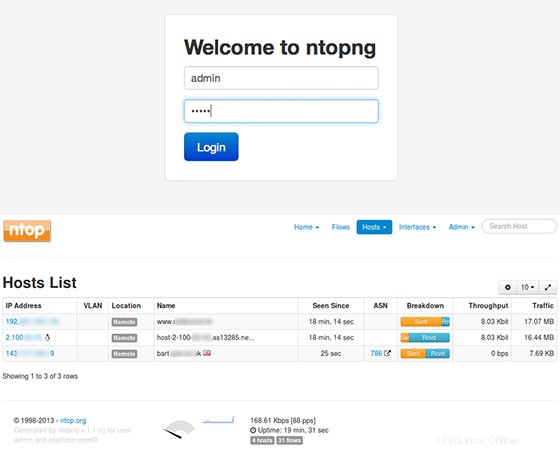
In questo tutorial, ti mostreremo come installare Ntopng su Ubuntu 18.04 LTS. Per chi non lo sapesse, Ntopng è uno strumento relativamente utile se stai cercando di monitorare diversi protocolli di rete sui tuoi server. Fornisce una serie di strumenti per il monitoraggio di vari protocolli, varianti di traffico e sì, larghezza di banda su più intervalli di tempo. Ntopng è basato su libpcap ed è stato scritto in modo portatile per funzionare virtualmente su ogni Piattaforma Unix, Mac OS e anche su Win32.
Questo articolo presuppone che tu abbia almeno una conoscenza di base di Linux, sappia come usare la shell e, soprattutto, che ospiti il tuo sito sul tuo VPS. L'installazione è abbastanza semplice e presuppone che tu sono in esecuzione nell'account root, in caso contrario potrebbe essere necessario aggiungere 'sudo ' ai comandi per ottenere i privilegi di root. Ti mostrerò l'installazione passo passo di Ntopng su un server Ubuntu 18.04 LTS (Bionic Beaver).
Prerequisiti
- Un server che esegue uno dei seguenti sistemi operativi:Ubuntu 18.04 e qualsiasi altra distribuzione basata su Debian come Linux Mint.
- Si consiglia di utilizzare una nuova installazione del sistema operativo per prevenire potenziali problemi.
- Accesso SSH al server (o semplicemente apri Terminal se sei su un desktop).
- Un
non-root sudo usero accedere all'root user. Ti consigliamo di agire comenon-root sudo user, tuttavia, poiché puoi danneggiare il tuo sistema se non stai attento quando agisci come root.
Installa Ntopng su Ubuntu 18.04 LTS Bionic Beaver
Passaggio 1. Innanzitutto, assicurati che tutti i pacchetti di sistema siano aggiornati eseguendo il seguente apt-get comandi nel terminale.
sudo apt-get update sudo apt-get upgrade
Passaggio 2. Installazione di Ntopng su Ubuntu 18.04 LTS.
Per installare Ntopng, esegui il seguente comando come utente root del tuo server:
wget http://apt.ntop.org/18.04/all/apt-ntop.deb dpkg -i apt-ntop.deb
Quindi, esegui:
apt-get update apt-get install pfring-dkms nprobe ntopng n2disk cento
Passaggio 3. Configura Ntopng.
Crea un file di configurazione Ntopng, in questo articolo utilizziamo nano come editor di testo. Puoi usare il tuo editor di testo preferito per creare file di configurazione Ntopng:
sudo nano /etc/ntopng/ntopng.conf
# /etc/ntopng/ntopng.conf # # The configuration file is similar to the command line, with the exception that an equal # sign '=' must be used between key and value. Example: -i=p1p2 or --interface=p1p2 For # options with no value (e.g. -v) the equal is also necessary. Example: "-v=" must be used. # # # -G|--pid-path # Specifies the path where the PID (process ID) is saved. # -G=/var/tmp/ntopng.pid # # -e|--daemon # This parameter causes ntop to become a daemon, i.e. a task which runs in the background # without connection to a specific terminal. To use ntop other than as a casual monitoring # tool, you probably will want to use this option. # -e= # # -i|--interface # Specifies the network interface or collector endpoint to be used by ntopng for network # monitoring. On Unix you can specify both the interface name (e.g. lo) or the numeric # interface id as shown by ntopng -h. On Windows you must use the interface number instead. # Note that you can specify -i multiple times in order to instruct ntopng to create multi‐ # ple interfaces. # -i=1 # # -w|--http-port # Sets the HTTP port of the embedded web server. # -w=3000 # # -m|--local-networks # ntopng determines the ip addresses and netmasks for each active interface. Any traffic on # those networks is considered local. This parameter allows the user to define additional # networks and subnetworks whose traffic is also considered local in ntopng reports. All # other hosts are considered remote. If not specified the default is set to 192.168.1.0/24. # # Commas separate multiple network values. Both netmask and CIDR notation may be used, # even mixed together, for instance "131.114.21.0/24,10.0.0.0/255.0.0.0". # -m=192.168.1.0/24 # # -n|--dns-mode # Sets the DNS address resolution mode: 0 - Decode DNS responses and resolve only local # (-m) numeric IPs 1 - Decode DNS responses and resolve all numeric IPs 2 - Decode DNS # responses and don't resolve numeric IPs 3 - Don't decode DNS responses and don't resolve # -n=1 # # -S|--sticky-hosts # ntopng periodically purges idle hosts. With this option you can modify this behaviour by # telling ntopng not to purge the hosts specified by -S. This parameter requires an argu‐ # ment that can be "all" (Keep all hosts in memory), "local" (Keep only local hosts), # "remote" (Keep only remote hosts), "none" (Flush hosts when idle). # -S= # # -d|--data-dir # Specifies the data directory (it must be writable). Default directory is ./data # -d=/var/tmp/ntopng # # -q|--disable-autologout # Disable web interface logout for inactivity. # -q=
Crea il file ntopng.start:
sudo nano /etc/ntopng/ntopng.start ##Add this line## --local-networks "192.168.0.0/24" ## give your local IP Ranges here. --interface 1
Per vedere tutte le interfacce e le opzioni disponibili, usa ntopng -h opzione:
sudo ntopng -h
Avvia il demone del server Ntopng:
systemctl start ntopng.service systemctl start redis-server.service
Passaggio 4. Accesso a Ntopng.
Ora puoi testare la tua applicazione Ntopng digitando http://your-server-ip-address:3000 . Vedrai la pagina di accesso di Ntopng. Per la prima volta, puoi utilizzare l'utente "admin" e la password "admin".

Congratulazioni! Hai installato con successo Ntopng. Grazie per aver utilizzato questo tutorial per installare l'analisi del traffico basata sul Web ad alta velocità Ntopng e la raccolta del flusso sul tuo sistema Ubuntu 18.04 LTS Bionic Beaver. Per ulteriore aiuto o informazioni utili, ti consigliamo di controllare il sito ufficiale di Ntopng.